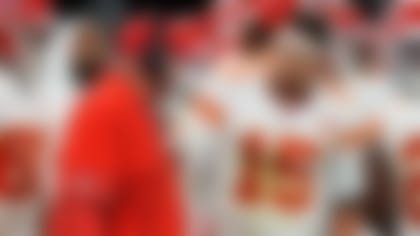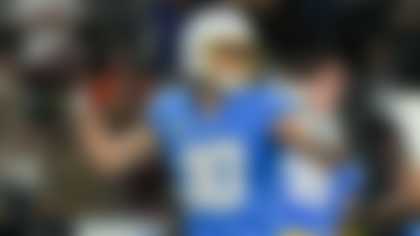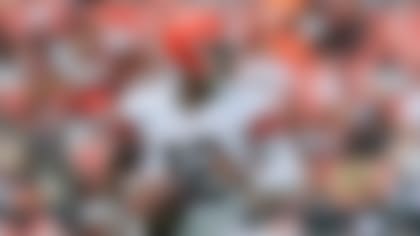(EDITOR'S NOTE: Shortly after this article was published, the Jacksonville Jaguars announced Urban Meyer as the team's new head coach.)
Former NFL player and scout Bucky Brooks knows the ins and outs of this league, providing keen insight in his notebook. The topics of this edition include:
-- Is Seattle about to return to a ground-and-pound formula?
-- A scintillating showdown between a receiver and corner at the height of their powers.
But first, a look at a seismic development in Duval County ...
Many naysayers will scoff at the notion of a college coach transforming a downtrodden NFL franchise into a Super Bowl contender, but I wouldn't bet against the prospect of Urban Meyer building the Jacksonville Jaguars into an AFC power in swift fashion.
NFL Network Insider Ian Rapoport and NFL Network's Tom Pelissero reported on Thursday that Jacksonville's working toward finalizing a deal with the highly accomplished coach (UPDATE: The team has since made the hiring official). Perhaps I'm a homer, due to my ties to the Jags as a former player and current broadcaster, but this feels like a slam-dunk pairing to me, with the ideal program-builder taking over a team in need of a makeover.
I know we've previously seen high-profile college coaches like Nick Saban, Steve Spurrier and Chip Kelly fail at the pro level, but this situation in Duval County could be the perfect storm for a dramatic turnaround. The Jaguars have a wealth of draft capital, immense salary cap space and emerging young talent that makes the setup in Jacksonville eerily similar to the one Jimmy Johnson came into in Dallas.
In case you forgot about the Pro Football Hall of Fame inductee's early days with the Cowboys, I should remind you that Johnson arrived in Big D after running up a 52–9 mark as head coach at the University of Miami. He inherited a 3-13 Cowboys squad fresh off its third straight postseason-free campaign, but armed with the No. 1 overall pick. Johnson snagged his franchise quarterback with his first selection (Troy Aikman), and then turned a treasure trove of draft picks -- many of which were acquired in the epic Herschel Walker trade of October 1989 -- into the foundation of a team that won back-to-back Super Bowls under his direction.
In Jacksonville, Meyer would step into a position where he could nab a generational talent at quarterback with the No. 1 overall pick in this year's draft and surround him with enough playmakers on each side of the ball to allow the young starter to flourish. Moreover, Meyer could build a roster with a mix of young and old players who fit into the ultra-competitive culture that he'd look to create in Jacksonville.
Sure, the doubters will point out that building an NFL team through the draft and free agency is far different than gobbling up five-star prepsters off recruiting lists, but I contend that talent evaluation and acquisition is about identifying top prospects and projecting their potential within a team's system. In addition, the college game is also about player development, and Meyer's experience as a supreme program-builder at various stops gives him unique perceptive on how to put the pieces together in an NFL outpost like Jacksonville. Yes, Meyer enjoyed significant advantages while working for the powerhouse programs at Ohio State and Florida, but he also transformed Utah and Bowling Green into regional powers. As the successful leader of two underdog programs, he has done more with less. Meyer's ability to transform imperfect rosters into championship-caliber outfits -- don't forget, he guided Utah to a perfect 12-0 season and final AP ranking of No. 4 in 2004 -- speaks volumes about his developmental process.
In Jacksonville, Meyer would walk into a small-market team that doesn't have the glitz and glamour of many other NFL franchises. He'd also inherit a roster that is young, inexperienced and lacking confidence. The Jaguars have lost 10-plus games in nine of the past 10 seasons, including a 1-15 mark in 2020 with 15 straight losses to close out the campaign. Meyer would need to heal those scars while showing a young team how to win games in a competitive division featuring hard-hitting squads with franchise quarterbacks.
That said, Meyer would face a steep learning curve moving up from the collegiate ranks to the NFL. He'd have to adjust to a different game and adapt to coaching pros who might be set in their ways. Also, he would have to recalibrate everything to the lengthier, more grueling NFL schedule, which would undoubtedly feature some gut-wrenching losses that could take a toll on his mental state and overall wellness, based on his competitive nature and past health issues. Finally, he'd need to have a trusted personnel executive within his inner circle to help him navigate the player acquisition process in the NFL.
While learning the NFL ropes is certainly challenging, I watched Jim Harbaugh take on a similar situation in San Francisco and promptly guide the 49ers to three straight NFC title games (with one Super Bowl appearance). He quickly transformed the Niners into heavyweight contenders utilizing a program that served him well at Stanford (and the University of San Diego). Given Harbaugh's immediate success, I wouldn't discount Meyer's chances of turning around the Jaguars despite his lack of NFL experience.
If Meyer can assemble a balanced coaching staff with some of his trusted assistants from the college ranks and some veteran NFL coaches with a similar vision, he could really jump-start the Jaguars with a proven plan that's worked at every previous stop. It certainly wouldn't be easy, but Meyer's track record suggests he could get it done in Jacksonville.
DINK AND DUNK
Are Russ' cooking days at an end? The grassroots "Let Russ Cook" movement had a real moment early in the 2020 campaign, with the Seahawks letting Russell Wilson throw the ball around the yard in the first half of the season -- but it appears to have definitively fallen out of favor with head coach Pete Carroll, who is poised to turn back the clock with a 3 yards and a cloud of dust strategy that emphasizes the running game.
"We have to run the ball better," Carroll said at his Monday press conference in the wake of Seattle's quick exit from the playoffs with a wild-card loss to the Rams. "Not even better -- we have to run it more. We have to dictate what's going on with the people that we're playing, and that's one of the ways to do that. And I know the fans aren't really jacked about hearing that, but Russ knows it, too. We need to be able to knock those guys into the scheme that we want to throw at."
The thought of the Seahawks re-embracing a ground-and-pound approach will make the 12s cringe, but it is a move designed to make the game easier for Wilson. After the football world watched the 'Hawks lead the NFL in passing yards per game (309.9) through the first 10 weeks of this season, defensive coordinators prominently featured two-deep coverage down the stretch to take away the deep ball and reduce the number of explosive plays.
Studying the All-22 Coaches Film, it was apparent defensive coaches instructed their safeties to align in the stadium parking lot to prevent Wilson from throwing over the top of the defense. The tactic worked well, with the Seahawks' scoring average dipping to 22.8 points per game over their final nine games (including playoffs) after sitting at 34.3 ppg during their first eight. A few days after the Rams ended their season, the Seahawks parted ways with coordinator Brian Schottenheimer.
The soft coverage also induced more turnovers from the veteran QB, who posted a career-worst 13 interceptions in 2020. Wilson's lack of patience and discipline led to a series of ill-fated throws into traffic that resulted in interceptions on tips and overthrows.
Considering the Seahawks were 12-0 in games with one or fewer turnovers and 0-5 with at least two turnovers (including the playoffs), Carroll's desire to run is really about playing winning football and dictating the terms to the opponent.
"That doesn't mean we're going to run the ball 50 times a game," Carroll said. "It means we need to run the ball with direction and focus and style that allows us to dictate the game."
To combat two-deep coverage, the Seahawks must be able to run the ball effectively against light boxes. A successful ground-and-pound attack will force opponents to drop an extra defender in the box, with a single safety in the middle of the field and corners isolated on islands.
"I want to see if we can run the ball more effectively to focus the play of the opponents and see if we can force them to do things like we'd like them to do more," Carroll concluded. "Like we have been able to do in the past."
In 2020, the Seahawks' early success was a byproduct of their run-heavy reputation leading defensive coordinators to aggressively defend the run with extra bodies. DK Metcalf and Tyler Lockett feasted on the one-on-one coverage, with their combination of speed, quickness and burst leading to explosive plays. The duo combined for seven receptions of at least 40 yards and 20 total receiving touchdowns this season. The big-play production led to the Seahawks' initial surge in points -- but Carroll knows he has to force opponents out of two-deep looks to create the explosive plays that the 12s love to see.
"Frankly, I'd like to not play against two-deep looks all season long next year," Carroll said.
The 12s can grumble about Carroll's old-school approach, but the Super Bowl winner is trying to reshape his offense to maintain its explosiveness while dictating terms to the defense. With the running game featured as the top priority, Carroll is attempting to create a sustainable style that keeps the 'Hawks in title contention.
Adams vs. Ramsey: A marquee matchup at Lambeau Field. The NFC Divisional Round matchup between the Los Angeles Rams and Green Bay Packers resembles a UFC championship fight in which Dana White handpicked the title card. The NFC semifinal game not only pits the league's No. 1 scoring offense (Packers) against its No. 1 scoring defense (Rams), but the bout also features a battle between Davante Adams and Jalen Ramsey -- the NFL's top receiver and the game's premier shutdown corner.
The one-on-ones between a pair of middleweights on the perimeter will give observers an opportunity to see how well an artistic route-runner fares against a skilled cover corner with world-class athleticism.
Adams, the first player in NFL history with 100-plus receptions and 18 or more touchdown catches in a single season, is a Picasso-like artist on the perimeter painting masterpieces on the grass. The 6-foot-1, 215-pounder displays outstanding balance, body control, stop-start quickness and burst while shaking and baking throughout his routes. Adams' creativity as a route-runner makes him a hard matchup in space, particularly with the Packers moving him around the formation.
For instance, Adams aligned in the slot on 29.9 percent of his routes this season, with an 83.6 percent catch rate (second-best in the NFL) and seven touchdowns (third most) from the alignment. He is at his best executing out-breaking routes (outs, flats and post-corners), with an NFL-best 23 receptions and five touchdowns on such routes from the slot.
Adams is the only receiver in NFL history to average eight-plus receptions per game and one-plus receiving touchdowns per game in a regular season, and the Packers make getting the ball to him a top priority. The Rams must find a way to contain No. 17 in order to slow down the league's top offense.
In Ramsey, the Rams have a shutdown corner with the size, speed and skills to limit Adams. Measuring 6-1 and 208 pounds, the former ACC indoor and outdoor long-jump champ is a versatile athlete with the capacity to play outside or in the slot. Ramsey's flexibility enables the Rams to deploy him as an eraser against the opponent's WR1. He held the likes of Amari Cooper, Stefon Diggs, Terry McLaurin, Allen Robinson, DK Metcalf, Mike Evans and DeAndre Hopkins to fewer than 60 receiving yards in his coverage, per Pro Football Focus.
The suffocating presence of Ramsey is reflected in the fact that he allowed a 50 percent completion rate (including the playoffs) while also holding receivers to the fewest receptions and yards when targeted (in the regular season). He held opposing receivers to just 309 receiving yards on 581 coverage snaps in the regular season. The Rams' CB1 has surrendered just 40 receiving yards on six receptions and 12 targets from the slot this season, including the playoffs. The All-Pro's effectiveness in coverage has played a major role in the Rams' pass defense ranking among the top eight in completion percentage (eighth), passing yards per attempt (first), passing touchdowns (first), TD-to-INT ratio (second) and passer rating (second).
With the Packers looking to target Adams early and often in this Divisional Round showdown, Ramsey's lockdown ability could determine whether the Rams win or go home this weekend.
Follow Bucky Brooks on Twitter.












